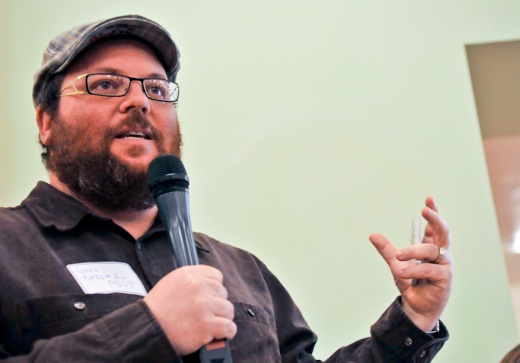
(Photo © J. Maus/BikePortland)
“… We’re going to have a neighborhood greenway system that will basically be like our bus system for walking and biking.. a basic level of service that serves the whole city.”
— Greg Raisman, PBOT
Like I’ve said in the past, the City of Portland’s work to establish a network of neighborhood greenways (a.k.a. bike boulevards) will have a transformational impact on our city. Yes, I would like to see our main commercial streets provide better bike access, and I’ve been critical of the lack of progress for bike access in the central city, but that should take nothing away from the great work happening on our residential streets.
Before I share an eloquent defense of neighborhood greenways by one of their most ardent supporters, let’s consider how far PBOT has come with them, just in the past few years.

In 2006, just 29% of Portland homes were located within 1/2 mile of a neighborhood greenway. In 2012, that number has more than doubled to 60%. Since PBOT has started to make these streets even better in recent years, usage of them has shot way up. In the last bike counts, bike traffic on the 11 most recently built neighborhood greenways shot up 61%.
At Tuesday’s Transportation Safety Summit, I happened to have my recorder on when PBOT traffic safety staffer Greg Raisman spoke up in defense of their neighborhood greenway work. In many ways, Raisman is the main architect behind Portland bike boulevard effort — if not in official terms than almost certainly in spirit. His dedication and enthusiasm for safety — and biking and walking in particular — is unmatched at the bureau.
His short, unscripted defense neighborhood greenways came in response to a question about whether or not investment in them is worth it.
I might have missed the first few seconds, but here’s what he said (it’s worth sharing verbatim):
“Portlanders are striving to make a place that is safe and comfortable to live in. I think the Portland Plan and the Healthy Connected Neighborhood strategy is really creating a model where we can think of, instead of a complete street, a complete transportation system. When we drive, we start on a residential street and work our way up to busier and busier streets. As we do that, the way that, the trip changes. As we are walking and biking we have that same kind of need. We need a complete, network strategy.
What we’re doing with this strategy and effort is to say, we’re going to have a neighborhood greenway system that will basically be like our bus system for walking and biking. It will be a basic level of service that serves the whole city. Everybody in the whole city should be able to have a basic level of active transportation that’s safe and accessible to them in their home.
The second thing is, really looking at civic corridors — busier streets that make major connections. These require much more significant investments and have much more significant engineering challenges… But key connections really need to be focused on to make those kind of connections for a complete system. We’re going to plant trees, we’re going to manage stormwater, we’re going to make it safe, we’re going to make it comfortable and we’re not going to just make it comfortable for the young, fit person, we’re really looking to make it comfortable and safe for everybody that lives in our city, and that’s why I’m excited.
In terms of the money side. Active transportation is just a great value. Our neighborhood greenway system to date, we have about 45 miles that will be completed by end of this year. We’re averaging about $141,000 a mile. To give you a sense of that, $250,000 buys one traffic signal. Building this network is a great value and when we leverage that on our busy streets that support local business and bring more money and people to those streets, making those major investments on those busy streets like Broadway and all these others are really important and that’s why people will continue to support it.”
And here’s the audio:
[audio:raisman_safetysummit.mp3|titles=Greg Raisman on neighborhood greenways]
This is good stuff to keep in mind when the media, politicians (existing or aspiring) try to frame spending on safe neighborhood streets as some sort of perk or simply a “bike route.” In addition to equating good bike streets with public transit, these words from Raisman are also interesting for his use of the term “civic corridors.” I hadn’t heard that used by PBOT before and it makes me wonder if that will become an official term for their main street efforts (UPDATE: Turns out “civic corridors” is a term in the Portland Plan. Thanks to Chris Smith for educating me. I’ll share more next week). PBOT has said all along, that the thrust behind neighborhood greenways was to “build the constituency” for bicycling that would eventually pressure City Hall to tackle the larger, more politically/financially/logistically hard stuff. Time will tell.

